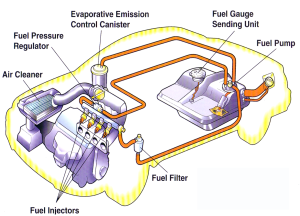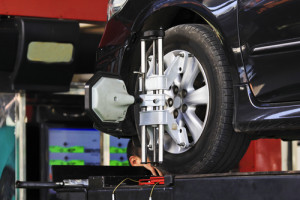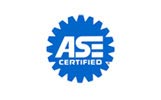The Importance of Fuel System Cleaning

Photo courtesy of http://tyrehouse.net.au/
Is your car acting sluggish or slow to accelerate? Have you noticed your gas mileage decreasing and find yourself filling up more than normal? If so, it might be time to check the importances of fuel system cleaning. It’s an often-overlooked maintenance element, but it can have huge effects on helping your car reach its optimal driving performance and fuel efficiency.
Fuel is obviously very important to your car, but it can also be the reason for uneven performance. As you drive, fuel injectors spray an incredibly fine line of fuel into the engine, much smaller than a grain of sand. That fuel is ignited and puts your car in motion. When you adjust the gas pedal, you are adjusting the amount of fuel that runs through the fuel system, and over time that wear and use can cause problems with performance, efficiency, and speed. Varnish and fuel deposits can build up over time, creating a fuel system that is lined with sludge. Similar in the way plaque builds up on your teeth and can affect the rest of your mouth, fuel buildup can affect the rest of your car’s performance.
It can be a little unnerving to realize such an important part of your car is running under less-than-ideal circumstances, but a periodic fuel system cleaning can set things straight again and is relatively simple. Most mechanics perform the cleaning in three steps: typically by running a series of cleaners through different parts of the fuel system and hand cleaning all of the parts to remove every bit of residue. In many cases, fuel system cleaning alerts technicians to the need for a fuel filter replacement, but that can also easily be taken care of at the same time.
Most mechanics recommend you get a fuel system cleaning every 12,000-15,000 miles, but you can definitely get them more often if you notice performance issues with your car. Some car types and designs are more sensitive to buildup in the fuel system, but if your car won’t benefit as much from the service, you can spread out your maintenance. Check with your mechanic to see where your car falls.
Regular maintenance, especially on the ever-important fuel components of your car, can greatly extend the life of the vehicle and save you money on gas and maintenance in the long run.
How to Tell if Your Car Needs An Alignment

One of the most common types of auto maintenance services is an alignment. There are many reasons for a car’s alignment to become an issue (keep reading to learn more details).
What’s important to understand, however, is that driving a car that is in need of an alignment can become a larger issue if not addressed. An unaligned car leads to uneven tire wear, which can cause tires to lose tread much quicker than they would in an aligned car. Excessive wear on your tires and suspension can be prevented with a simple preventative maintenance plan. For the good of your car and your wallet, taking the preventative measure of having your vehicle aligned can save hundreds of dollars and prolong the life of your tires.
How to Tell if Your Car Needs an Alignment
In order to drive optimally, the steering and suspension systems in your car must be calibrated perfectly. This keeps the tires in good alignment and ensures smooth driving. Minor shifts in the way these systems are calibrated can result in a wheel misalignment that negatively impacts your driving. When this happens, it’s time to get an alignment done.
A misalignment can be very subtle, so you might not notice it while driving. Fortunately, there are a few signs you can look for when determining whether your car needs an alignment. We’ll go over these in detail, but first, let’s look at what exactly causes your car to get unaligned.
Causes of Misalignment

Everyday driving, traffic, uneven roads, and the normal stresses that driving puts on your vehicle will naturally wear on your car’s tires and alignment. As a result, even the world’s best drivers still face alignment issues. Sometimes, this can happen faster than usual as your car encounters uneven roads, potholes, curbs, etc.
Other factors that speed up misalignment issues include uneven weighting on your vehicle (such as if you have a constant heavy load in the trunk), reckless driving, and poor balance of tire air pressure. Over time, these can all put stress on the suspension and steering systems in your vehicle, leading to a shift in wheel alignment.
The issue isn’t with the tires, but rather with the suspension of the car that causes tires to tilt or bow in or out. Normal driving can cause parts of the suspension to rotate, tweak, or bend. Alignment is measured by the angles of your tires from the side and from the top of the car. Once you’ve had your car aligned, you will likely be able to tell a big difference in the ease of driving and the car’s overall performance.
Signs to Look For
Every 5,000 to 6,000 miles, your car should be taken in for an alignment just to keep everything finely tuned. There isn’t a warning light or any kind of alignment notification from your car, but most manufacturers recommend getting your car aligned every 6,000 miles or so. Before going through with the entire alignment, have a mechanic check your suspension to see if it is need of an alignment.
In addition, the following signs can indicate that your vehicle’s wheels are misaligned:
- Vehicle pulling to the side. If you notice that your car naturally tends to veer or pull slightly in one direction, even when you are carefully trying to drive perfectly straight; it’s probably time for an alignment. A properly aligned car will drive straight when the steering wheel is straight, but an unaligned car might drift to the side with a straight steering wheel or require lots of correction.
- Uneven tire wear. One of the easiest ways to tell if your car is unaligned is to check the tire tread. Ideally, tires will wear evenly on all sides. A car in need of an alignment will have fairly obvious wear that is uneven between the edges of the tire. If you notice feathering or uneven wear on your tires, it may be time to schedule your vehicle alignment.
- Vibrating steering wheel. If your steering wheel is working hard to keep your car moving straight when the wheel isn’t centered, it is common for the steering wheel to vibrate or hum. If this is an issue with your car, it may not be aligned.
- Squealing tires. If your tires squeal semi-regularly, it could mean your car’s alignment should be checked.
- Crooked steering wheel. If your steering wheel is slightly crooked when you’re heading straight, this could indicate it’s time to see the mechanic.
When you take your vehicle in for an alignment, the mechanic will perform additional tests to find signs of these problems. The tests are designed to gauge the tires for slanting in any direction, including:
- Camber angle, or the slant of the tire on an up-and-down angle as viewed from the front.
- Toe alignment, or the way tires might point inward or outward when viewed from above.
- Caster angle, or any forward or backward slant of the steering axis when viewed from the side.
These angles are difficult to see without the proper equipment, but they have a major effect on the way your car handles.

After Your Alignment
Once everything has been fixed with regards to your car’s alignment, your car will be able to drive optimally once again. Some of the specific benefits you’ll see include:
- Easier handling.
- Less resistance between your tires and the road, leading to less tire wear and longer tire life.
- Improved gas mileage due to reduced tire resistance.
- No more vibration or veering issues.
No car is completely immune to wheel misalignment, but it is fairly inexpensive to fix, especially when compared to the price of new tires. Careful driving, reducing the load in your car, maintaining proper tire air pressure, and getting an alignment every 6,000 miles can all keep your car driving smoothly for much longer. In the meantime, if you notice any of the above signs, take your car in for an alignment as soon as possible.
A vehicle alignment is an easy way to prolong the life of your tires, make your car more enjoyable to drive, and help balance things out on rough roads. It doesn’t take much effort or maintenance to make a big difference.
Call Autotailor, your Greeley auto repair specialists to schedule an appointment today.
Brake Fluid Testing – Is It Necessary?
When you are tackling the roads of Greeley on a daily basis, you may give little thought on considering the level of your brake fluid. This is a big mistake as this seemingly insignificant fluid in your vehicle can have a big impact on the safety of you, your loved ones and other drivers. To stay on top of things it is important that you have brake fluid testing carried out and levels topped off when needed.
Brake fluid testing is it necessary the process of testing for moisture in the brake fluid of a vehicle. The only standard way of carrying out this testing is to boil the brake fluid.
Checking Your Brake Fluid for Moisture
On the back of every brake fluid bottle, there is a chart demonstrating the dry and wet boiling points of all the different grades of brake fluid. Manufacturers of the brake fluid use a test procedure known as the Equilibrium Reflux Boiling Point to find out the boiling point of the brake fluid. As brake fluid testing is performed in a laboratory, this process can take hours to start and complete.
The quickest way of performing the brake fluid test can be achieved by making use of a tester, which is designed to test the boiling point of the brake fluid in the vehicle within 30 seconds with digital precision. It performs well on all grades of the brake fluid and shows exactly what level the brake fluid has boiled at, and what the minimums of the Department of Transportation are for each grade. This simplifies the process of changing the brake fluid for the customer and the technician.
Once the vehicle’s brake fluid has been changed, the workshop can offer to test the brake fluid again by making use of the tester, to clearly demonstrate the improved effects on the new brake fluid. Consumers should also be aware that the new brake fluid from a conserved bottle can be used for each brake change.
Get Yours Tested Today
The brake fluid is an item for the safety of the vehicle as well as for the driver. However, most drivers in Greeley, Colorado do not know the importance of the brake fluid test! They know about their oil and windshield wiper fluid, but both repair garages and vehicle manufacturers have mostly ignored the brake fluid test, which is not safe for both the vehicle and the driver. If it has been a while since you had your brake fluid levels checked, get yours checked today!
Why Are My Brakes Squeaking? A Road Safety Reminder.
Road accidents can catch us off guard and possibly cause serious harm. Brakes that are operating at 100% are a life line when traveling, so if your brakes are making squeaking noises and you choose not to have them checked by a qualified auto mechanic, you may be at risk. Brakes are undeniably one of the most important safety features of automobiles so it is vital to have them working properly in times when you need them most.
Why Are My Brakes Squeaking? A Road Safety Reminder.
Squeaky brakes or the lack of brake fluid are just some factors that can cause problems. All of these can panic a seasoned driver as well as a newbie at a moment’s notice. While some brake noise is normal, loud and persistent squeaking requires a visit to the mechanic. Here are some DIY road safety tips that you can easily do to fix the noise problem:
– Apply dampening paste or milk spray on the brake pads.
– Replace any shims or clips that are loose.
– Check the brake rotor or drum for grooving or wear.
– Check for loose parts and replace if necessary.
– Use sand paper, resurface the rotors.
– Use high quality brake pads.
With the options above, it is still highly advisable that you let a professional check your brakes out first. They can provide you with expert advice and quality service that you need. A professional auto mechanic can also help differentiate between squeaking that indicates a problem, and squeaking that is normal. However, when brakes are near to going bad, they are designed to make noise which is a clear and early sign that they need replacement.
If you have Questions about Why Are Brakes Squeaking? Give Autotailor a call today at (970) 353-3401.
Routine Auto Maintenance…Are You Shortening Your Vehicle’s Life Span?
When you drive your car, it is important that it drives smoothly, gets great mileage and keeps you safe. This is where routine auto maintenance becomes more important. Routine auto maintenance is what keeps you from drifting as you drive or your engine from making loud noises. It keeps your belts running smoothly and your engine operating in peak performance. Performing routine maintenance and knowing when your car needs to be serviced can save you a lot of time, money in unnecessary repair costs, and make your overall driving experience more enjoyable.
The Importance of Motor Oil
Many of the routine maintenance tasks we perform have to do with fluid levels. Oil is one of the most important levels to check because without the proper amount of oil, your whole engine can become damaged and even seize up costing you thousands in engine replacement costs. The oil keeps parts from rubbing together as you drive, and it is one of the easiest and most common fluids to replace. Simply check your oil levels once a week and replace as necessary. Every three months or 5000 miles, you should take your car to Autotailor to have an oil change.
A Note on Warrantees
Many vehicles come with mileage warrantees that are designed to protect you financially should something major break on the vehicle. Not performing and documenting routine auto maintenance can void these warrantees leaving you on the hook financially for the repairs to your vehicle. Always document all routine maintenance visits!
Checking Other Fluids
Your car has other important fluids that need to be maintained at certain levels. These fluids include brake fluid, transmission fluid, coolant and windshield wiper fluid. The needs of a vehicle will vary a little bit depending on the make, model and type, but in general, keeping these fluid levels optimal is essential to your vehicle running at its best. Check your owner’s manual to see where the fluid can be checked and replaced in your vehicle or simple come into Autotailor and we’ll handle it for you.
Maintaining Your Tires
Having perfect tires is crucial to driving. In order to keep your tires working efficiently, you will need to check the tire pressure and alignment on a regular basis. If your tire looks like it is lacking air or one of your tires is having uneven wear, get your tire pressure and alignment checked immediately. If the same tire becomes low on air again you may have a leak that can be plugged. When you get your oil changed, have your Autotailor mechanic inspect and balance your tires.
Replacing Worn Parts
Aside from oils and fluids, there are some parts that get worn as you drive. These parts need to be replaced on a regular basis in order to keep the car moving safely. The most common parts to replace due to normal wear and tear include brake pads and mufflers. These replacements should be performed by a qualified mechanic.
Are You Shortening Your Vehicle’s Life Span? Give Autotailor a call today at (970) 353-3401 for your vehicle repair and diagnostic needs!



